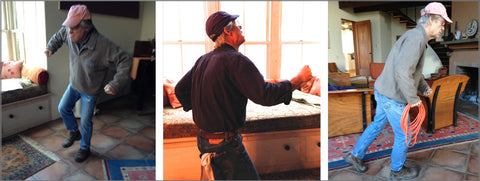Unabridged: a Charlesbridge Children's Book Blog
E-I-E-I-O! Illustrating Old MacDonald Had a...Zoo?! 6
Iza Trapani stops by to chat about her process for illustrating her new book Old MacDonald Had a...Zoo?
The illustration process for all my books starts the minute I begin a story. My head fills with images, and I start doodling and storyboarding as I work on the manuscript. I find it really helpful to figure out the pagination, to know what text will go on each page. That way I can pace the story, see where I can cut words, change things around, and make sure to move the story forward from page to page. I sketch the storyboard on an 18” x 24” sheet of paper and layout all thirty-two pages of the book on it. Here is the entire storyboard:

And here is a close up:

As you can see, these are very rough sketches. I redo them as needed and glue on revised sketches. That’s why it’s all such a sloppy mess! Then I doodle some larger sketches, like this one:

Then I sketch and re-sketch. I use a tracing/sketching paper to draw on. This allows me to trace over other images, and if I flip the paper over it’s easy to see irregularities or errors (like one eye lower than another…). Here is the final approved dummy sketch for the above page:

Here it is painted in watercolor and acryla gouache:

Early on, I do character studies in different poses:

My husband is a convenient model and has posed for this and previous books.



And in case you are wondering what’s in the next scene…



The chickens, rooster, horse and dog in this book are friends’ pets. The cat is ours. I also browse endless Google images and books for the animals, scenery, architecture, and whatever I will need to draw. And I drive around and take many of my own photos. So much work goes into the illustrations: sketching, re-sketching, researching, checking for consistencies (in characters, setting, colors), painting, repainting…
The cover is especially important. Contrary to the old adage, we DO judge a book by its cover. It needs to hint at what the book is about and also be appealing. Here are some cover sketches/designs I had done:




And some color studies:




Here’s the final sketch and cover as approved by Charlesbridge:


Poor Old MacDonald…He just wanted to milk his cow and have a normal day on the farm.

Not so…


But all is well in the end.


Well, almost…

E-I-E-I-O!
Purchase Old MacDonald Had a...Zoo? for your readers today!
- Mel Schuit
My Five Favorite Scenes from Select 0
Select author Marit Weisenberg digs deep and narrows down her five favorite scenes from her author debut. Warning: spoilers ahead!!
1. When the entire pack of sixteen highly-evolved teens break the rules and go out in public as a group
This is my most favorite scene, and, because it was the first scene I imagined and the seed that grew into a whole story, I think of it as the heart of the book. It is extra special because it takes place at one of my favorite spots in Austin: Barton Springs, a natural spring-fed pool that has been referred to as the crown jewel of Austin. I move the scene through different aspects of the location — the steep slope of the lawn under the pecan trees, the crowds on all sides of the enormous pool, as well as the serious chill of the water and the eerie plant life floating beneath the surface.
Marit with Executive Editor Monica Perez
2. When the teens are arrested
This scene was inspired by imagining the night the Kennedys and their power brokers handled Teddy Kennedy’s accident in Chappaquiddick, an incident that resulted in the death of a young woman. The thought of the wealthy and powerful brazenly exerting their influence over the local authorities has always lived large in my mind. And, in other stories, I’ve always loved scenes when officers do their jobs and then find out from a higher up that they’ve accidentally messed with someone powerful who they should have stayed away from.
3. When Julia meets her former bad boy crush and longtime best friend Angus at the dock
I love stories about boy/girl friendships. Friendships between straight males and females can be so complicated, especially as they evolve over time. Even if lives go in different directions, even if one or both have had feelings for the other, I think there is always an extra special bond when two people have grown up together and have a shared history. Nothing can erase that.
Marit giving a talk at Book People in Texas
4. When the long overdue blow up takes place between Julia and her younger, breathtaking half-sister, Liv
This was also one of the hardest scenes to write because it had to be full of things the sisters have always been afraid to say out loud. From the beginning stages of writing Select, I knew I wanted to examine a blended family with a very uneasy, unspoken dynamic. What’s it like having a stepparent who makes you feel unwelcome in your own home? And how do children from a first and second marriage who are being raised together deal with the unequal division of love? This scene is where it all comes to a head between two sisters who really love each other but whose loyalties are being tested.
5. When Julia arrives at John’s house at dawn
This scene embodies what I love to write about most: the roller coaster of first real love. I wanted my novel to have romance and heartbreak and that out-of-control feel when the heart has completely taken over despite thinking you’d moved on. Most importantly, I wanted to include how very scary it can feel to make yourself vulnerable to another person.

Purchase Select for your readers today!
- Mel Schuit
Books That Make You Go "Hmmm..." 0
I got a chance to catch up with Monica Perez, Executive Editor of CharlesbridgeTEEN about her experience launching a new imprint with us at Charlesbridge. Check out charlesbridgeteen.com to check out the books!
When the Charlesbridge team first started discussing a young adult imprint, everyone was excited. Up to that point, our house had published a handful of middle grade fictional titles, including the much-lauded Samurai Rising, which had pushed the boundaries of its age category. It seemed only logical to continue expanding into the teen and crossover markets. In terms of topics and genres, the sky was the limit!
Monica Perez (l) and Editorial Director Yolanda Scott (r)
But being open to any story under the sun turned out to be perhaps a little broad when it came time to sign up new titles and to start publicizing them. . . We needed a mission statement. But first we had to examine why we were acquiring certain books.
One way to think about different kinds of stories, and why they work for some readers, is the mirror and window analogy. For example, some teens will look for books that touch on topics they already know and like, and which may reflect their own selves or lives—like a mirror. Other teens are open to or actively seeking books that expand their worldview or present a reality very different from their own (including fantasy)—a veritable window to peer through. What could these diverse books have in common? After some consideration, we gleaned that both kinds can inspire their readers to think deeply, to question, and to read further.
And so we landed on this official goal:
CharlesbridgeTEEN features storytelling that presents new ideas and an evolving world. Our carefully curated stories give voice to unforgettable characters with unique perspectives. We publish books that inspire teens to cheer or sigh, laugh or reflect, reread or share with a friend, and ultimately, pick up another book. Our mission—to make reading irresistible!
Each one of our Fall 2017 launch titles fits very nicely into this description.
Blood and Ink, by Stephen Davies, is a book about two teens who get caught up in a life-of-death situation during an invasion of modern-day Timbuktu by Islamic fundamentalists. Ali and Kadi are on opposite sides of the conflict but they find common ground in a shared love of the written word—a small connection that might be key to saving lives. We can’t think of a better time to be publishing a book that encourages people to move beyond their differences and discover common elements of their humanity.
Running Full Tilt, by Michael Currinder, is a semiautobiographical debut novel about two brothers who have a complicated relationship. Leo is a high school junior who discovers he has a talent for running after he must consistently run out the back door and away from his older brother Caleb’s fists. There’s no easy solution for repairing their relationship, partly because Caleb is autistic and developmentally-delayed. But their lives have also been interrupted by a recent move and marital troubles between the boys’ parents. It doesn’t mean that Leo won’t find hope and support from classmates, a new girlfriend, and his success on the track—proving the old adage that when one door closes, another opens. We are champions of this book for its authentic voice, thrilling race scenes, and the fact that it tackles tough subjects with sensitivity.
Select, by Marit Weisenberg, the first book in The Select series, is an atmospheric debut novel that can best be described as speculative fiction. What if humans could evolve into something. . . more? For Julia Jaynes and her extended family, they’ve made such a leap. They are strong, athletic, beautiful, strikingly perceptive, and able to affect their world in ways that seem practically supernatural. They are also arrogant, powerful, calculating, ruthless, and ultra-secretive. Julia has never felt like she fit in, most especially when she falls for high school tennis star and outsider John Ford. If Julia rejects the prejudices of her family to be with a normal human, she will also have to leave the group forever. What attracted us to this story of otherness versus belonging is that Julia’s journey of self-definition is a universal one—the quest to be loved, respected, and understood by those around you.
We hope you enjoy discovering these new and new-to-Charlesbridge authors and their unique, thoughtful stories. And we sincerely hope you come back for more!
Purchase Blood & Ink, Running Full Tilt, and Select for your readers today by visiting charlesbridgeteen.com!
- Mel Schuit
Determination in the Face of Religious Extremism 0
Stephen Davies, author of Blood & Ink, ponders an increasing determination to stay strong in the face of religious extremism.
In February 2012 I was living with my wife and daughter in the arid north of Burkina Faso, West Africa. We had learned Fulfulde, the language of Fulani cattle herders, and were experiencing the normal joys and frustrations of cross-cultural living. For my day job I worked in a tiny, oven-hot recording studio, producing radio dramas in Fulfulde with local actors. In my free time I wrote adventure stories, mostly set in Africa’s Wild West, the Sahara Desert.

photo courtesy of Mark Gibson
One day my friend Muhammed Mintao came to see me at home. We sat under a straw shade shelter and made gunpowder tea on a tiny wire stove. Muhammed is a camel trader from Timbuktu. He came to Burkina Faso as a refugee in the 1980s.

photo courtesy of Mark Gibson
"Trouble is coming," muttered Muhammed, his anxious eyes gazing out between the voluminous folds of his turban. "The Tuaregs of the Sahara are going to mount a rebellion. They are digging up the rifles that they buried long ago."
Two weeks later Muhammed’s prediction became a reality. His extended family became hosts to thousands of refugees who were pouring across the border to escape the violence in Mali. For my own part, radio drama quickly took a a back seat to humanitarian aid work. Many of the refugees had arrived with nothing but the clothes they wore.

photo courtesy of Joseph Hunwick
Muhammed was disturbed by the stories these refugees were telling. The Tuareg rebellion had been hijacked by a group of well-funded Islamist extremists. The proud Muslim cities of Timbuktu, Gao and Kidal were being subjected to a harsh and alien form of sharia law. Music and dancing, even musical ringtones, were banned. Girls as young as five were being forced to cover their faces. Playing football was outlawed.

photo courtesy of Mark Gibson
Not all of the stories were so gloomy. There were tales of spirited resistance, of a women’s protest march, of secret singsongs and romantic trysts. Perhaps most amazing of all, they told of a heroic smuggling operation being undertaken by Timbuktu’s librarians, trying to prevent the city’s treasure trove of ancient manuscripts from being plundered or burned by the occupiers.

photo courtesy of Joseph Hunwick
Blood & Ink is my first foray into historical fiction. Although I had long been writing adventure stories, I had never encountered a real-life Saharan drama which so completely demanded my attention. I wrote the book during NaNoWriMo 2013 and redrafted it in subsequent months. On its UK publication, Cethan Leahy called the book “an exciting combination of sweeping romance, adventure, danger and history”. I am excited about its upcoming US publication and grateful to Charlesbridge for enabling it to reach a wider audience.
Other writers and film-makers were similarly inspired by stories coming out of Timbuktu, including the great Malian film director Abderrahmane Sissako. His 2014 film Timbuktu is an arresting and tender portrayal of a city under sharia. The football-less football clip below is one of many memorable scenes from the film that show people’s determination to remain true to themselves in spite of the pressure of religious extremism.
My family and I returned to the UK in 2014. We are now living in London, which has also come under the shadow of terrorism in recent times. How do we resist extremism yet at the same time recognize the humanity and fragility of those who have been beguiled by extremist narratives? I hope that my novel Blood & Ink explores this question in good conscience and that it might even suggest some answers.
Purchase Blood & Ink for your readers today!
- Mel Schuit













